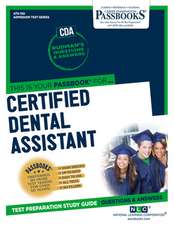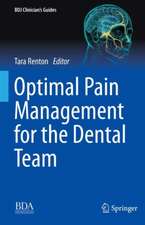Clinical Guide to Accelerated Orthodontics: With a Focus on Micro-Osteoperforations
Editat de Mani Alikhanien Limba Engleză Hardback – 7 mar 2017
| Toate formatele și edițiile | Preț | Express |
|---|---|---|
| Paperback (1) | 640.30 lei 38-44 zile | |
| Springer International Publishing – 3 mai 2018 | 640.30 lei 38-44 zile | |
| Hardback (1) | 1030.64 lei 3-5 săpt. | |
| Springer International Publishing – 7 mar 2017 | 1030.64 lei 3-5 săpt. |
Preț: 1030.64 lei
Preț vechi: 1084.88 lei
-5% Nou
197.21€ • 206.46$ • 163.18£
Carte disponibilă
Livrare economică 15-29 martie
Specificații
ISBN-10: 3319433997
Pagini: 132
Ilustrații: XI, 132 p. 88 illus., 83 illus. in color.
Dimensiuni: 155 x 235 x 14 mm
Greutate: 0.4 kg
Ediția:1st ed. 2017
Editura: Springer International Publishing
Colecția Springer
Locul publicării:Cham, Switzerland
Cuprins
Biological Principles of Accelerated Tooth Movement.- Different Methods of Accelerating Tooth Movement.- Introduction to Micro-Osteoperforations (MOPs).- Step-by-Step Guide for Performing MOPs.- Incorporating Catabolic Effects of MOPs at Different Stages of Treatment.- Anabolic Effects of MOPs (Cortical Drifting).- Utilizing Anabolic Effects of MOPs in Daily Mechanotherapy.- Long Term Effects and Advantages.
Notă biografică
Mani Alikhani, MSc, DMD, PhD, is the founder and Director of the Consortium for Translational Orthodontic Research (CTOR; orthodonticscientist.org). He is a faculty at Harvard School of Dental Medicine and The Forsyth Institute (Boston and Cambridge, Massachusetts). He is a Visiting Professor in Orthodontics at Xi’an Jiaotong University College of Stomatology, China. He serves as a reviewer for many scientific journals and an editorial board member for PLOS ONE, Seminars in Orthodontics, and Journal of Tissue Science & Engineering. He also serves as a reviewer in many NIH (National Institutes of Health) Study Sections. Dr. Alikhani has authored numerous peer-reviewed articles, chapters, and books; one of which is the first animated e-book in orthodontics - Mechanotherapy in Orthodontics. Dr. Alikhani’s research is supported by NIH and several international foundations, and his research efforts in orthodontics and bone biology have produced many patented innovations in clinical orthodontics. Dr. Alikhani has private orthodontic practices in New York and New Jersey.
Textul de pe ultima copertă
This book is a complete reference for all clinicians who are interested in incorporating into their daily practice the techniques available to reduce the duration of orthodontic treatment and to overcome other treatment limitations. It focuses especially on micro-osteoperforations (MOPs) as the most conservative, efficient, and versatile approach to increase the rate of tooth movement. The opening chapters describe the biological principles of current accelerated techniques at the molecular and cellular levels and introduce guidelines on how to select the best acceleration approach based on each patient’s needs. Clinicians are then guided step by step through the application of MOPs, case selection, and treatment planning. It is explained how MOPs can be incorporated into daily mechanotherapy for the treatment of different malocclusions and how to take advantage of the catabolic and anabolic effects of the procedure to expand the boundary of orthodontic and orthopaedic corrections. The book is written in a simple and clear language with many illustrations and clinical examples to facilitate understanding of concepts and procedures. In addition, it is a rich source for academicians and researchers interested in a comprehensive and updated review on theories of tooth movement and accelerated orthodontic techniques.
Caracteristici
Guides the reader step by step through the application of micro-osteoperforations (MOPs)
Describes how MOPs can be incorporated into daily mechanotherapy
Includes many illustrations and clinical examples
Descriere
This book is a complete reference for all clinicians who are interested in incorporating into their daily practice the techniques available to reduce the duration of orthodontic treatment and to overcome other treatment limitations. It focuses especially on micro-osteoperforations (MOPs) as the most conservative, efficient, and versatile approach to increase the rate of tooth movement. The opening chapters describe the biological principles of current accelerated techniques at the molecular and cellular levels and introduce guidelines on how to select the best acceleration approach based on each patient’s needs. Clinicians are then guided step by step through the application of MOPs, case selection, and treatment planning. It is explained how MOPs can be incorporated into daily mechanotherapy for the treatment of different malocclusions and how to take advantage of the catabolic and anabolic effects of the procedure to expand the boundary of orthodontic and orthopaedic corrections. The book is written in a simple and clear language with many illustrations and clinical examples to facilitate understanding of concepts and procedures. In addition, it is a rich source for academicians and researchers interested in a comprehensive and updated review on theories of tooth movement and accelerated orthodontic techniques.






















